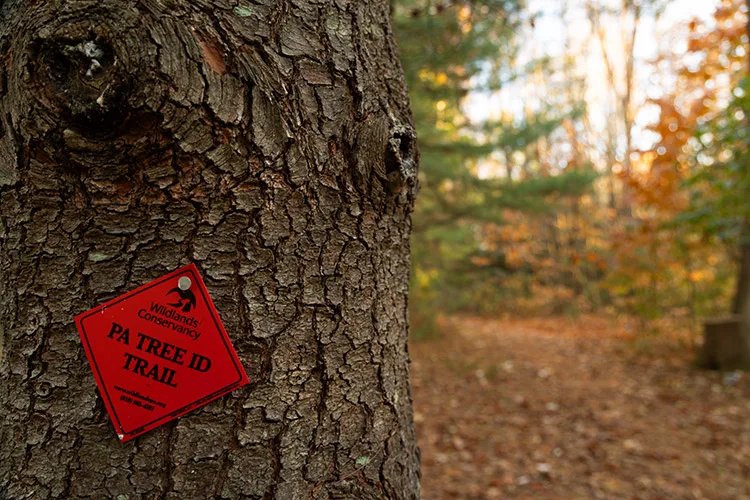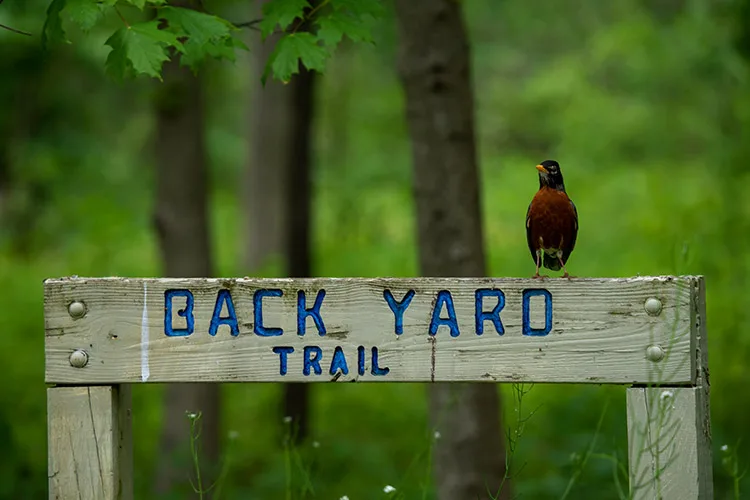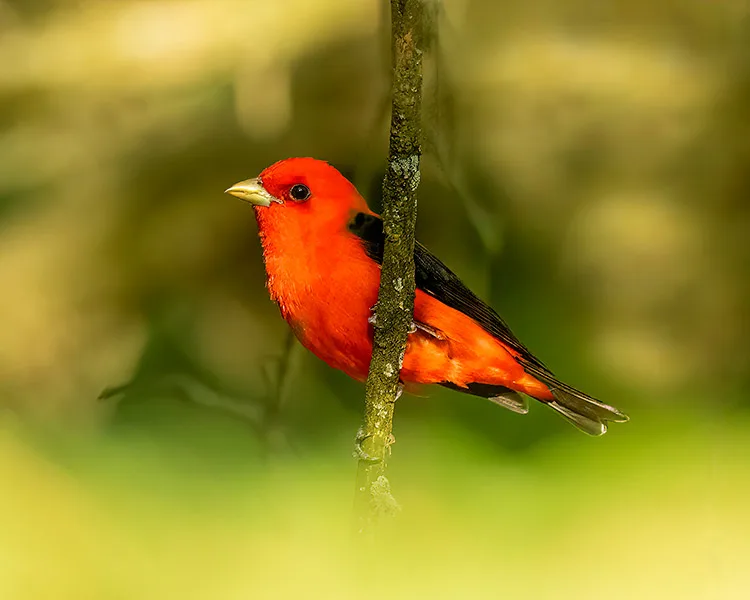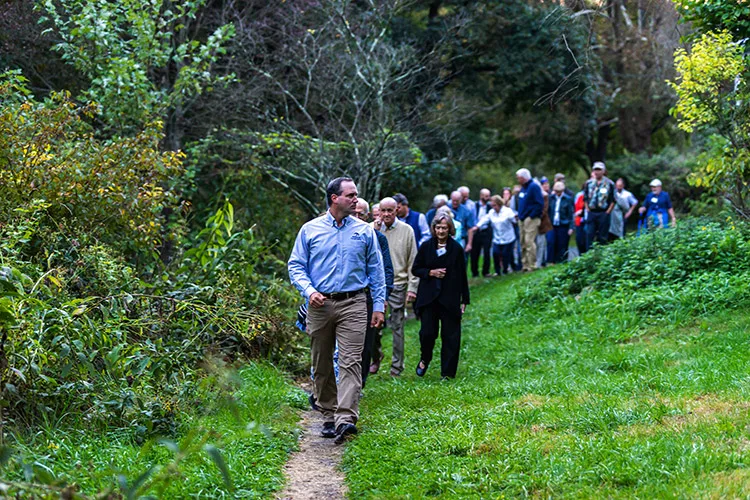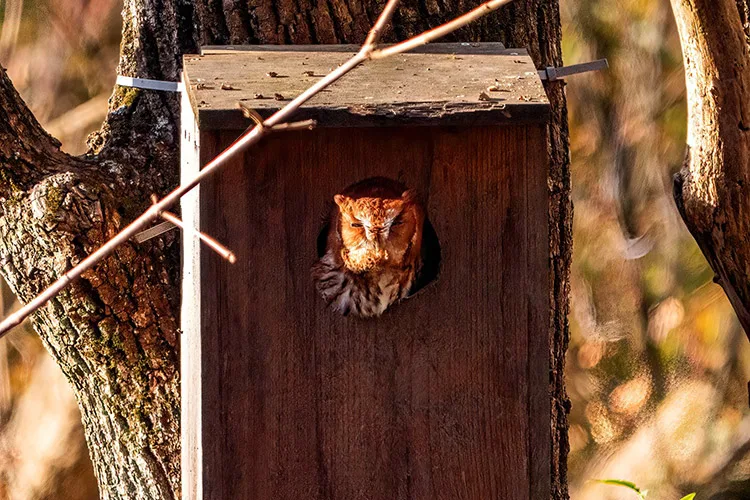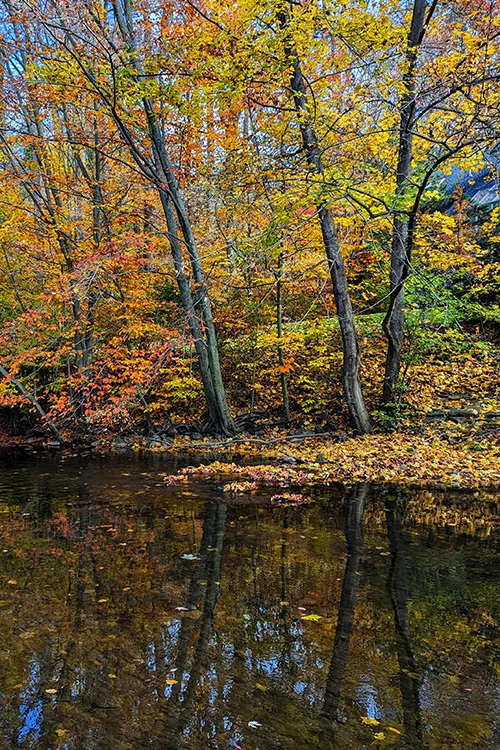This 77.5-acre nature preserve hosts the headquarters of Wildlands Conservancy, the main office, and is an outdoor classroom for environmental education for thousands of school-age kids annually. It boasts nearly three miles of trails including the iconic boardwalk on the Floodplain Trail that runs along the Little Lehigh.
Backyard Conservation Trail | 0.4 miles | Moderate
The Backyard Conservation Tree is a hilly, steep trail that runs on a ridge above the Little Lehigh. The trail passes through dense upland habitat before connecting to the Woodlands Trail and Sensory Tree. Spurs from this trail lead to the bird blind and a small pond.
Floodplain Trail | 0.4 miles | Easy
This shady boardwalk trail runs through the wetland riparian zone (vegetative space along waterways) along the Little Lehigh Creek, passing ponds and stream overlooks. This trail is ADA accessible, with dedicated parking located nearby.
PA Tree ID Trail | 0.1 miles | Easy
The PA Tree ID Trail is a great example of native tree species- each labeled for easy identification. This short, flat trail forks to connect to Pheasant Run at both ends.
Pheasant Run Trail | 0.5 miles | Easy
This flat trail runs through a mix of hardwood and evergreen groves, with thick understory shrubs. The trail then loops through a sunny wildflower meadow where red-tailed hawks and foxes are occasionally spotted. ADA parking is available in the grassy area near Pheasant Run’s entrance and provides easy access to the pavilion and Floodplain trail.
Sensory Trail | 0.5 miles | Moderate
The Sensory Trail provides rope-guided hiking and environmental educational opportunities for the visually impaired. Braille signs and tactile sensory displays provide an interactive experience. This region of the preserve is open meadow with lots of sun and wildflowers. Access to the sensory trail is available off Farr Rd, with a dedicated parking lot and pavilion.
Switchback Trail | 0.4 miles | Moderate
This trail switchbacks up the hill from its beginnings near the Bird Blind and Wildflower Meadow. This trail provides an easier, less steep, route for accessing the Woodlands trail than the Backyard Conservation trail. Forest and grassy areas are interspersed along this route and dense stands of yellow-blooming Wingstem create a unique corridor.
Woodlands Trail | 0.4 miles | Easy
The Woodlands trail is the most remote of the trails on the preserve. This area contains some of the most mature woodlands on the property and as the quietest trail, often exhibits the largest number of interior woodland bird species.
Dorothy Rider Pool Wildlife Sanctuary’s diverse habitats (young meadows, forest, and the Little Lehigh) provides habitat for 136+ bird species including bald eagle, Baltimore oriole, Canada warbler, hooded merganser, red-breasted nuthatch, blue heron, red-tailed hawk, and great horned owl. The bird blind is a great place to glimpse a variety of bird species.
Other wildlife includes red fox, turtles, and deer . Several ponds provide the opportunity for frogs, salamanders, dragonflies and damselflies to thrive. Large butterfly species such as common clearwings, monarchs and imperial moths find homes with their host plant species in our native wildflower meadows.
This preserve hosts our animal ambassadors which educate thousands of students per year on the importance of conservation in the region. These animals include Bartram the eastern screech owl, maple the opossum, and Aster the skunk. We ask nature preserve visitors to stay behind the rope at the animal ambassador viewing area.
The wildflower meadows bloom with milkweed, bee balm, flowering trees, native sunflowers, and other pollinator-friendly native wildflowers. Many trees close to the buildings and parking lot are part of the history of the preserve, such as the yews and sweetgum trees.
This preserve’s place in our history is thanks to the vision of Air Products founder, Leonard Parker Pool, who bequeathed the sanctuary to Wildlands in 1975. Parker Pool was a founding member of the Lehigh Valley Conservancy – now known as Wildlands Conservancy. Leonard purchased this property with the intent of converting it from a cattle farm into a wildlife preserve and donated the property to the conservancy in his will for that purpose. Remnants of the previous use still exist, including the 1800s farmhouse, which today holds Wildlands’ main office, and the 1869 Pennsylvania German bank barn.
To commemorate the Air Products Foundation becoming the largest philanthropic investor in Wildlands’ history in 2012, Wildlands named the environmental education building at Dorothy Rider Pool Wildlife Sanctuary the “Air Products Environmental Education Center.”
– Preserve is open from dawn to dusk
– No motor vehicles, bicycles, or horses
– Be respectful of neighbors and private property
– Do not damage, disturb, or harm any plants, wildlife, or geology
– No collecting of these natural resources
– Do not dump or litter; carry out all trash
– Pets must be leashed, under control at all times, and cleaned up after
– Be respectful of others using the property; quiet increases the chances of viewing wildlife
– No glass containers
– No camping or fires
– No alcohol, illegal drugs, or weapons
– Stay on trails
– No hunting or trapping
Help protect our preserves!
It costs $400,000 a year to manage our
nature preserves. Give today to help!






